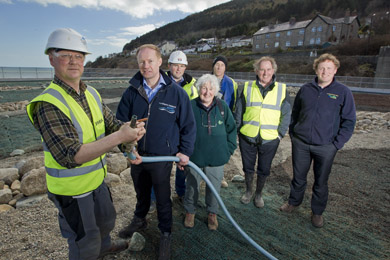REGIONAL Development Minister Danny Kennedy welcomed the introduction of a unique planting programme to ‘green’ up the roof on NI Water’s new £8 million extension to the wastewater treatment works at Newcastle harbour.
Using a special process known as hydroseeding, the top of the new fifty metre-long concrete structure has been sown out with a special mix of indigenous coastal seeds to provide a soft green area which not only offers a more attractive view for the overlooking properties, but which also provides a natural habitat for local birds and insects.
[caption id="attachment_38432" align="alignleft" width="390"] Kieran Grant, NI Water Oriject Manager, Fergus Bannon, Dawson-Wam Ovivo, Jo Whatmough, and Michael Carey, right, Mourne Heritage Trust, with local landscape and seeding experts.[/caption]
Kieran Grant, NI Water Oriject Manager, Fergus Bannon, Dawson-Wam Ovivo, Jo Whatmough, and Michael Carey, right, Mourne Heritage Trust, with local landscape and seeding experts.[/caption]
Congratulating everyone involved in the project, Minister Kennedy said: “The Mournes area is one of the most spectacular landscapes in Northern Ireland and all efforts to maintain its beauty and eco-friendliness are to be commended. It is important to protect our valuable scenic coastline and Newcastle Wastewater Treatment Works now blends in more with the natural surroundings.”
Acknowledging the input from local landscape and ecology experts, the Minister said: “In developing this green roof NI Water has been very fortunate to have been able to glean knowledge from a number of local experts with experience of coastal areas, not least members of the Mourne Heritage Trust and I would like to thank them for the time that they have dedicated to this project so far. I know that they, along with NI Water, look forward to seeing how the ecological value of the area increases as the green roof matures.”
Kieran Grant, NI Water Project Manager for the scheme explained: “From the outset of this project our aim was to take all practical steps to minimise the visual impact of a large concrete structure on the shoreline within the Mournes Area of Outstanding Natural Beauty, and in doing so, enhance the ecological value of the area by providing a herb-rich coastal grassland habitat for plants, insects and birds.”
Working with local landscape experts from the County Down area and members of the Mourne Heritage Trust, NI Water devised a low-maintenance landscape plan that would be rich in biodiversity.
Bill McIlwaine, from Killinchy-based McIlwaine Landscape Architects, explained how the grey concrete structure was prepared to go green.He said: “The make-up of the green roof comprises a drainage layer of natural gravel topped with a thin layer of lightweight soil laid on a separation/filter membrane. Drifts of natural gravel and boulders from local gravel pits provide additional visual and ecological interest. The seeds for the natural grassland were sown by a process of hydro-seeding which means they were mixed with water, fibres and binders and sprayed on to form a surface mulch which resists disturbance by wind and rain while germination takes place.”
As a further measure towards improving habitats for seabirds, NI Water and its contractors for the project, Dawson-Wam – working with local ecologist, Shaun Wolfe-Murphy – have erected nesting ledges for Kittiwakes on the seaward side of the new building and have developed a resourceful system for nesting boxes out of drainage pipes and small manhole systems. These will be placed high up on the rock armour which surrounds the entire building and it is hoped that many of the Guillemots who flock to the area will make use of them as secure nesting places.
All civil construction work on the new extension has been completed and inside the new treatment works, mechanical and electrical work is continuing on the extensive reams of process systems required to operate the new plant. The extended treatment works has been equipped with a new UV treatment stream which is due to be brought on line at the end of May 2013.
This will deliver an improved standard of discharge to local bathing waters in line with future European Directives. Overall work at Newcastle WwTW is programmed for completion around September, with commissioning, testing and monitoring procedures continuing until the end of the year.
]]>
























